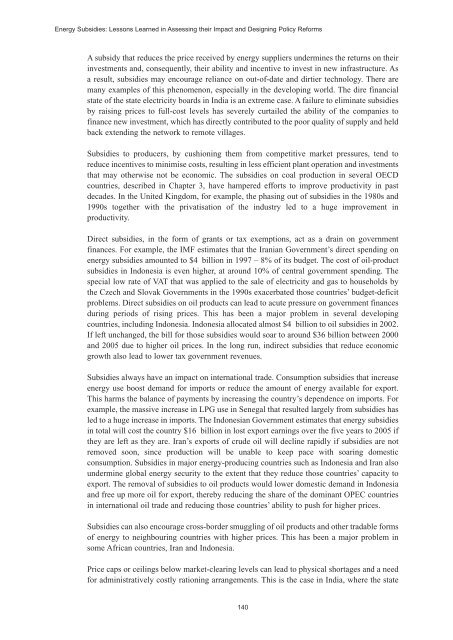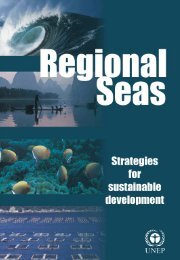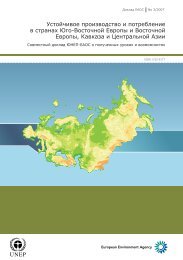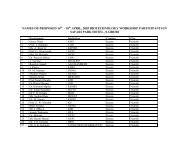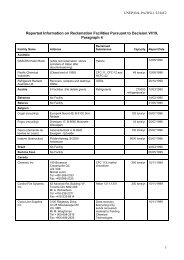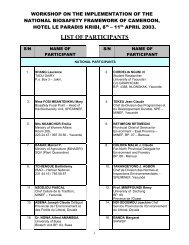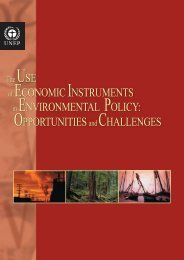Energy Subsidies: Lessons Learned in Assessing their Impact - UNEP
Energy Subsidies: Lessons Learned in Assessing their Impact - UNEP
Energy Subsidies: Lessons Learned in Assessing their Impact - UNEP
Create successful ePaper yourself
Turn your PDF publications into a flip-book with our unique Google optimized e-Paper software.
<strong>Energy</strong> <strong>Subsidies</strong>: <strong>Lessons</strong> <strong>Learned</strong> <strong>in</strong> Assess<strong>in</strong>g <strong>their</strong> <strong>Impact</strong> and Design<strong>in</strong>g Policy Reforms<br />
A subsidy that reduces the price received by energy suppliers underm<strong>in</strong>es the returns on <strong>their</strong><br />
<strong>in</strong>vestments and, consequently, <strong>their</strong> ability and <strong>in</strong>centive to <strong>in</strong>vest <strong>in</strong> new <strong>in</strong>frastructure. As<br />
a result, subsidies may encourage reliance on out-of-date and dirtier technology. There are<br />
many examples of this phenomenon, especially <strong>in</strong> the develop<strong>in</strong>g world. The dire f<strong>in</strong>ancial<br />
state of the state electricity boards <strong>in</strong> India is an extreme case. A failure to elim<strong>in</strong>ate subsidies<br />
by rais<strong>in</strong>g prices to full-cost levels has severely curtailed the ability of the companies to<br />
f<strong>in</strong>ance new <strong>in</strong>vestment, which has directly contributed to the poor quality of supply and held<br />
back extend<strong>in</strong>g the network to remote villages.<br />
<strong>Subsidies</strong> to producers, by cushion<strong>in</strong>g them from competitive market pressures, tend to<br />
reduce <strong>in</strong>centives to m<strong>in</strong>imise costs, result<strong>in</strong>g <strong>in</strong> less efficient plant operation and <strong>in</strong>vestments<br />
that may otherwise not be economic. The subsidies on coal production <strong>in</strong> several OECD<br />
countries, described <strong>in</strong> Chapter 3, have hampered efforts to improve productivity <strong>in</strong> past<br />
decades. In the United K<strong>in</strong>gdom, for example, the phas<strong>in</strong>g out of subsidies <strong>in</strong> the 1980s and<br />
1990s together with the privatisation of the <strong>in</strong>dustry led to a huge improvement <strong>in</strong><br />
productivity.<br />
Direct subsidies, <strong>in</strong> the form of grants or tax exemptions, act as a dra<strong>in</strong> on government<br />
f<strong>in</strong>ances. For example, the IMF estimates that the Iranian Government’s direct spend<strong>in</strong>g on<br />
energy subsidies amounted to $4 billion <strong>in</strong> 1997 – 8% of its budget. The cost of oil-product<br />
subsidies <strong>in</strong> Indonesia is even higher, at around 10% of central government spend<strong>in</strong>g. The<br />
special low rate of VAT that was applied to the sale of electricity and gas to households by<br />
the Czech and Slovak Governments <strong>in</strong> the 1990s exacerbated those countries’ budget-deficit<br />
problems. Direct subsidies on oil products can lead to acute pressure on government f<strong>in</strong>ances<br />
dur<strong>in</strong>g periods of ris<strong>in</strong>g prices. This has been a major problem <strong>in</strong> several develop<strong>in</strong>g<br />
countries, <strong>in</strong>clud<strong>in</strong>g Indonesia. Indonesia allocated almost $4 billion to oil subsidies <strong>in</strong> 2002.<br />
If left unchanged, the bill for those subsidies would soar to around $36 billion between 2000<br />
and 2005 due to higher oil prices. In the long run, <strong>in</strong>direct subsidies that reduce economic<br />
growth also lead to lower tax government revenues.<br />
<strong>Subsidies</strong> always have an impact on <strong>in</strong>ternational trade. Consumption subsidies that <strong>in</strong>crease<br />
energy use boost demand for imports or reduce the amount of energy available for export.<br />
This harms the balance of payments by <strong>in</strong>creas<strong>in</strong>g the country’s dependence on imports. For<br />
example, the massive <strong>in</strong>crease <strong>in</strong> LPG use <strong>in</strong> Senegal that resulted largely from subsidies has<br />
led to a huge <strong>in</strong>crease <strong>in</strong> imports. The Indonesian Government estimates that energy subsidies<br />
<strong>in</strong> total will cost the country $16 billion <strong>in</strong> lost export earn<strong>in</strong>gs over the five years to 2005 if<br />
they are left as they are. Iran’s exports of crude oil will decl<strong>in</strong>e rapidly if subsidies are not<br />
removed soon, s<strong>in</strong>ce production will be unable to keep pace with soar<strong>in</strong>g domestic<br />
consumption. <strong>Subsidies</strong> <strong>in</strong> major energy-produc<strong>in</strong>g countries such as Indonesia and Iran also<br />
underm<strong>in</strong>e global energy security to the extent that they reduce those countries’ capacity to<br />
export. The removal of subsidies to oil products would lower domestic demand <strong>in</strong> Indonesia<br />
and free up more oil for export, thereby reduc<strong>in</strong>g the share of the dom<strong>in</strong>ant OPEC countries<br />
<strong>in</strong> <strong>in</strong>ternational oil trade and reduc<strong>in</strong>g those countries’ ability to push for higher prices.<br />
<strong>Subsidies</strong> can also encourage cross-border smuggl<strong>in</strong>g of oil products and other tradable forms<br />
of energy to neighbour<strong>in</strong>g countries with higher prices. This has been a major problem <strong>in</strong><br />
some African countries, Iran and Indonesia.<br />
Price caps or ceil<strong>in</strong>gs below market-clear<strong>in</strong>g levels can lead to physical shortages and a need<br />
for adm<strong>in</strong>istratively costly ration<strong>in</strong>g arrangements. This is the case <strong>in</strong> India, where the state<br />
140


